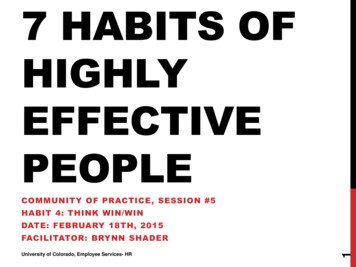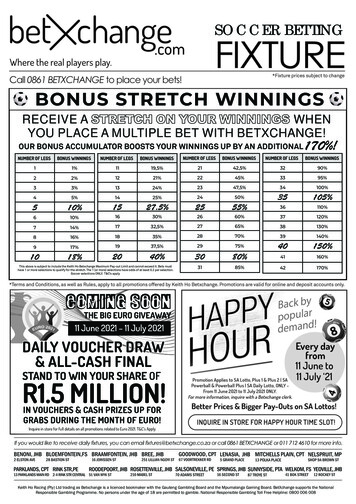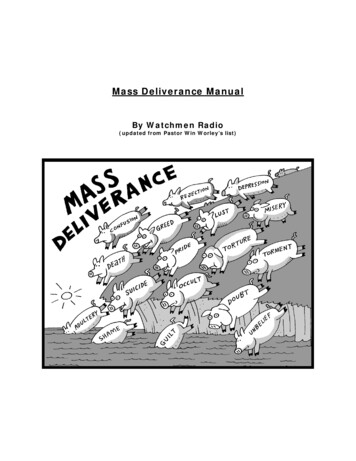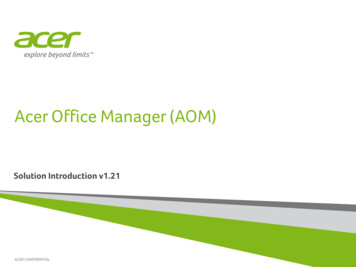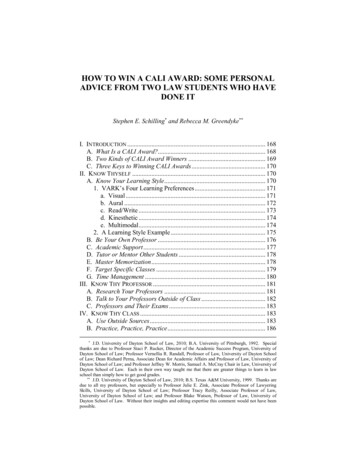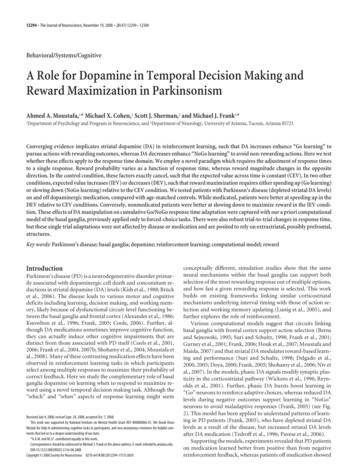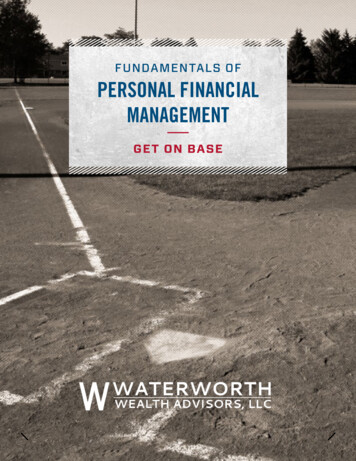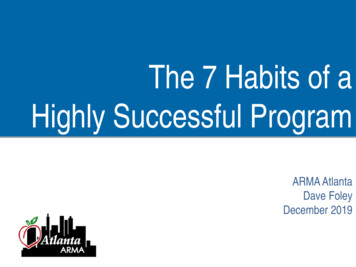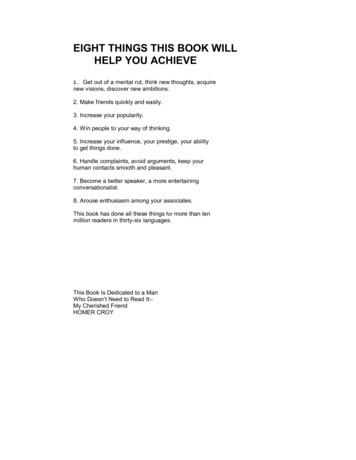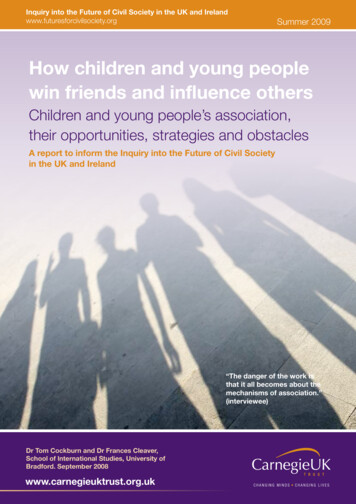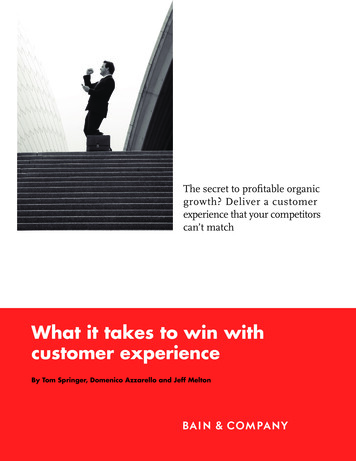
Transcription
The secret to profitable organicgrowth? Deliver a customerexperience that your competitorscan’t matchWhat it takes to win withcustomer experienceBy Tom Springer, Domenico Azzarello and Jeff Melton
Tom Springer is a Bain & Company partner based in Boston. DomenicoAzzarello is a Bain partner based in Paris. Jeff Melton is a Bain partner basedin Sydney. All three are senior members of Bain’s Global Customer Strategy &Marketing practice.Copyright 2011 Bain & Company, Inc. All rights reserved.Content: Editorial teamLayout: Global Design
What it takes to win with customer experienceThe secret to profitableorganic growth? Delivera customer experiencethat your competitorscan’t matchGreat customer experiences produce greatbusiness results. Look at companies such asApple, Costco, American Express, Philipsand Allianz. Different industries, differentbusiness models. But they have one thing incommon—large and growing groups of passionate customer advocates, earned by deliveringan experience competitors can’t match. That,more than anything else, is why these companies lead their industries in profitableorganic growth.Every company can tap into that power. Andmaking the commitment to deliver a superior customer experience can turn a laggardinto a fierce competitor, or an “also ran” organization into an industry leader. CharlesSchwab is an example. Between 2003 and2005, Schwab was a troubled company thathad a compound annual growth rate of –3.6percent. Over the next two years, it began adramatic recovery, growing at an average rateof 17.5 percent, and by 2008 it had regainedits position as an industry leader. One bigreason for the change: Schwab’s large investments in creating a stellar customer experience.The company’s Net Promoter score (NPS )—the percentage of advocates or “promoters” amongits customers minus the number of detractors—rose from -34 percent to 42 percentin the five years between 2005 and 2010. That’sa record-setting increase.Why don’t more companies emulate Apple,Schwab and others that win with customerexperience? It’s a long, hard road, especiallyfor companies that have neglected their customers. Turning that around requires energyand resources, and it takes time. But the journey is not mysterious, and the rewards aresubstantial. Our research and experienceover the past several years have led us tothree fundamental insights that can helpyou get there:1.Understand loyalty economics. An outstanding customer experience createspromoters, and promoters are more valuable to a company than other customers.Customer experience leaders analyzeloyalty economics in detail, so that everyone in the organization knows notonly where to invest but how much andwhat the payoff will be.2. View the experience from the outsidein. Customers don’t see the web of organizations and processes that operatebehind the scenes to deliver their experiences. They see that series of interactionsfrom the outside in, colored by their expectations and their alternatives. Customerexperience leaders embrace the sameperspective, rising above internal complexity to see and manage the whole picturefrom the customer’s point of view.3.Design and deliver. You don’t need to bea Steve Jobs to create this kind of customer experience. Yes, it is hard, andyes, it takes time. But it’s a process thatcan be learned and launched like any major change program. Eventually it can bebuilt into an organization’s DNA.Let’s take a deeper look at these three insightsand explore how companies—the up-andcomers as well as the leaders—are using themto outstrip the competition.1
What it takes to win with customer experience1. Understand your loyalty economics to build the business casefor changeThe logic that connects customer experienceto bottom-line results is simple. If people lovedoing business with you, they become promoters. Promoters are the customers that everycompany wants more of. They’re less likely todefect. They buy more products and servicesover time. They sing your praises to friends,colleagues and complete strangers over socialnetworks, in online reviews, through blogsand in every conceivable channel. They costless to serve, and they provide constructivefeedback. All of these behaviors have direct,quantifiable economic benefits, as our colleaguesFred Reichheld and Rob Markey demonstratein their book The Ultimate Question 2.0 (HarvardBusiness Review Press, September 2011). Youcan determine how much a promoter is worthto you in incremental sales and profits, andyou can use that analysis to determine whereand how much to invest in improving thecustomer experience.This direct link between promoters and business results helps to clarify what it takes to bea customer experience leader. Some peoplebelieve that a leader should delight every cus-tomer. Others argue for eliminating defects inproducts and interactions, or reducing the effortcustomers spend in dealing with a company.We think these arguments miss the point. Delight, quality and reduced effort may all bepart of the package, but the goal of change hasto be the creation of promoters. They are thecustomers who produce the economic benefitsfor your business. Everything else is simply ameans to that end.We see loyalty economics play out across mostindustries. A study of six different industries,for example, shows an order-of-magnitudegap on both NPS and organic revenue growthbetween the industry leaders and laggards(see Figure 1). To take just one example,Chick-fil-A’s NPS exceeds 60 percent and itsfour-year compound annual growth rate is11.5 percent. The laggard in the fast foodbusiness had a negative NPS and a negativegrowth rate.2. View the experience from theoutside inMany companies define the customer experience from the inside out. When they try toimprove the experience, they look at each ofthe individual functions that affect the expe-Promoters, detractors and NPSHow do you know if a customer is a passionate fan—a promoter? The easiest way is to surveyyour customers on a regular basis right after key interactions. Using a zero-to-ten scale, askthem how likely they would be to recommend your company (or a particular product) to afriend or colleague.Scores of nine or ten, we have found, represent promoters. These customers stay longer, buymore and recommend you to their friends. That’s why creating more of them leads to profitablegrowth. Scores of seven and eight indicate passively satisfied customers, and scores of zerothrough six indicate unhappy customers—detractors. Your Net Promoter score (NPS ) is simplythe percentage of promoters minus the percentage of detractors.2
What it takes to win with customer experienceFigure 1: Relative Net Promoter score (NPS) and growth rates of NPS leaders and laggardsRevenue growth CAGR (05–09)AirlinesNPS (2010)Fast foodAuto insurance*GroceryCell phone service** Retail .00.0 1.2 5JetBlue AirlinelaggardChick fil AFast foodlaggardNPSUSAAAutoinsurancelaggard0 2.2 3.3Trader GroceryJoe’s laggardLeader revenue growth20Verizon Cellphoneservicelaggard 20TDRetailBank bankinglaggardLaggard revenue growthNote: Revenue growth shown excluding impact of acquisitions*Auto insurance revenue measured in direct premiums written; **cell phone service revenue measured by service revenues;***retail banking revenue measured in domestic depositsSource: Satmetrix NPS data; SNL Financial; Euromonitor; company annual reportsrience—marketing, customer service and soon. Leaders turn this approach on its head.They examine the experience from the customer’s point of view, and they use that perspective to make improvements and managethe experience.Viewed from the outside in, a customer’s experience results from three types of interactions: The brand, such as advertisements, marketing communications and signage The offering—the specific characteristicsof products and services and how customers use or experience them The touch points, including stores, contactcenters, websites, social media and customer communitiesAll three types of interactions, alone or incombination, play a role in creating promoters,but their relative importance depends on theindustry and the company’s positioning withinit. For automobile manufacturers, productinteractions are typically the most importantfactor that determines promoters. The importance of product may be even higher for anauto manufacturer attempting to differentiatethe customer experience through innovativeengineering, such as BMW. For consumerproperty and casualty insurers, it’s the interactions with sales and service touch points thatmatter most. The customer experience leadersmake it a point to learn which parts of thewhole experience are most important to eachsegment of their target customers, and theninvest to differentiate on those dimensions.Customer experience engages both sides ofthe brain. Executives work hard to get the economic details of their offerings right, and theyshould. But we human beings are emotionalcreatures as well as rational ones. We want3
What it takes to win with customer experienceCustomers useboth sides oftheir brains toevaluate thecompanies theydo businesswith. This iswhy it’s so important to buildan emotionalconnection aswell as a rational one.good value and efficiency, but we also want tolike and trust the companies we patronize. Wewant to feel good about ourselves when we dobusiness with them. We’ll put up with less thanperfect service if we feel that the people we’redealing with care about us, are trying hard andwill get there in the end (see Figure 2).This is the classic left brain-right brain dichotomy, and it shows up repeatedly in Bain’sstudies of what’s most important to customers.Listen to a woman we interviewed as she describes her passion for Verizon. She’s a promoter—but it isn’t just because of pricing orother economic benefits:“Everything in my house is Verizon. Thecell, the FIOS, the TV, the Internet, everythingis Verizon. Whenever there’s an issue, a problem, you call up, you get great customer service on the phone . It makes you feel valued,like you’re important to them . Whether it’sgreat training or they just hire great people,they’re not rushing you, they’re taking thetime to actually talk to you it feels personal,it absolutely does . It’s a great brand, whereyou’re going to trust that they’re going to takecare of it. I’ve never been disappointed.”It’s much the same with detractors. Peoplemention emotional disappointments—“Theydon’t seem to care,” or “They don’t treat youwith respect”—in the same breath with economic ones. They are equally important.Customer experience evolves. Customers evaluate each interaction in the context of theones that came before and compare it withtheir expectations and alternatives (see Figure3). A series of positive interactions buildstowards higher willingness to recommend,creating a promoter. One negative interactionat a “moment of truth” can turn an advocateinto an antagonist if it isn’t quickly recognizedand addressed. That’s why consistency is soimportant. Customers become promoters whenall key interactions leave them with a positiveimpression relative to what they have experienced elsewhere.The winners’ circle: One out of nineHow many companies capitalize fully on the well-documented connections between customerexperience, customer advocacy and economic performance? Only a handful. Our latest studyof 140 US consumer products and consumer services companies measured relative growthand profitability along with brand equity, Net Promoter scores and other gauges of customersatisfaction. We turned up just 15, or about one out of nine, that were leaders on all thesemeasures. Little surprise that the list includes so many household names:4American ExpressCostcoMetroPCSTrader Joe’sAppleJetBlueNew York LifeUSAAAT&TKohl’sNordstromVerizonChick-fil-ALG Electronics USATD Bank
What it takes to win with customer experienceFigure 2: A series of positive interactions goes beyond “completely satisfied”Series of positive interactions over timeLeft brain (rational)CustomerRight brain (emotional)1 32“Completely satisfied” “Completely satisfied” They deliver as promisedMy needs are metI get value for moneyInteractions are easyI trust themThey treat me with respectThey share my valuesThey make me look good“Delighted”“Delighted” They do the little things exceptionally well They consistently exceed expectations I feel connected with them I’m proud to be a customerFigure 3: Positive interactions over time earn customer advocacyRetail banking exampleHighWillingness to recommend“The peopleare friendly”Low“This isfrustrating!”“The bank willbe convenient”“That was niceof the managerto check in”“The rep wasvery helpful”Open newcheckingaccountChargedVisit branchand greeted unexpectedmaintenanceby namefee“I don’tunderstandthis fee”Customerservice repremoves feeTimePromoterPersonally loyal;likely torecommendPassivePersonally loyalMonthly Call to customer Follow upcall fromstatement service rep toresolve issuemanagerreceivedwith balancediscrepancy“The rep said direct deposithad not hit yet and confirmed everything is OK”DetractorAt risk ofdefection; likelyto detractAlternatives (e.g., offers from other banks)Expectations set by the bank and other service providers5
What it takes to win with customer experienceThe “three Ds”—design, deliveryand DNA—arethe keys to aconsistentlygreat customerexperience.Many companies require afew years toget them right.3. Design differentiation into yourexperience, deliver consistentlyand develop your company’s DNAAny company can create the kind of customerexperience that sets it apart from the competition. Though it involves a serious commitment,it is mostly a matter of getting just three thingsright. They are the “three Ds”: design, deliveryand DNA.Design a better experience for your target customers than your competitors offer. The startingpoint is identifying and studying your mostprofitable customer segments, then determining the economics of promoters and detractorswithin those segments. That allows you topropose and evaluate potential investments inimproving their experience.Here’s how the Dutch airline KLM did it. Researching its customers, the airline saw that itcould realize some 100 million in new contribution margin by converting about 20 percentof its highest-value customers into new promoters.But what would really turn them into passionatefans? Executives identified several possiblethemes and began to implement the most promising ones. Because KLM knew that its mostprofitable travelers valued their time highly,one theme was “Make It Speedy.” The Make ItSpeedy initiative brought some quick, visiblewins, such as establishing priority security linesfor elite flyers, relocating gates to reduce walkingtimes and launching a mobile check-in application. Over time, it would include everythingfrom faster booking to a prearranged car waitingfor the traveler upon arrival. The result was adramatic change in how time-pressed targetcustomers felt about their trip—and about theairline that was providing it.Deliver a great experience consistently, withseamless integration across all touch points.The next step is to implement the changes—6to put systems in place so that things workright every time and customers get the feeling,“Wow, they’re really taking good care of me.”American Express, for example, found thatcustomers who lost a charge or credit card encountered several obstacles when they triedto replace it. Some couldn’t find the right number to call. Others had trouble with the automated menu system and abandoned the call,or else reached a rep who couldn’t handle thetask of replacing a card. Executives defined andimplemented defect-free processes for all suchcalls—and along the way realized they coulddelight their best customers by overnightingthem their new cards. An expensive move? Notreally. It reduced the number of calls abouteach lost card, and customers could begin making purchases again with their cards muchsooner. Overnight delivery was a “wow,” but arelatively frugal one.Build a customer orientation into your company’s DNA. Customer experience leaders focuson the customer twenty-four hours a day, sevendays a week. Their goals, values and operationsall reflect that focus. Their employees knowthat creating a great experience is part of theirmission, and they are empowered to do so. WhenCharles Schwab began its turnaround, it developed a state-of-the-art Net Promoter systemthat provided regular, timely feedback fromcustomers. Based on that system, the company’sleaders developed a customer-focused culturebased on using that feedback for learning andimprovement. Senior executives talked aboutthe customer experience regularly, and madeit a part of all ongoing business reviews andstrategy discussions. Branch managers begantalking to customers every day and learned totake quick action to address many of the issuesthat arose. The company built the customerexperience into its employee training programsand reinforced the importance of a great experience through the internal website and othercommunications. The upshot: Schwab’s program
What it takes to win with customer experienceto transform its customer experience becamean integral part of the company’s way of working. “Senior leadership really grasped thisconcept,” explained one vice president. “It really resonated with how they thought aboutthe business.”Mapping the process of changeThese elements—design, deliver and DNA—frame the process of change (see Figure 4).Of course, every company’s journey is different, because each one starts from a differentplace and has its own unique strengths andweaknesses. But the essential elements ofeach journey are usually similar.Actually doing it, of course, can feel like climbing a steep mountain. Companies typicallyfind that they have to modify or overhaul manyaspects of their business, seemingly all at once.They need rigorous, thorough customer analytics and a system of feedback. They need todevelop products and offers tailored preciselyto the needs of their target customers. Theyneed IT systems that can offer consistent customer contact, efficient billing and provisioning,and robust customer intelligence. Over thelonger term, they need metrics and benchmarksof the sort created at Schwab, so that everyonein the organization knows how they are doing.The people must be on board as well. Leadersneed to create an explicit vision of the customer experience and then walk the walk, backingup their commitment with action and investment. The front line must learn how to takeresponsibility for the customer experience.Putting it all together is a challenge, but manycompanies are doing just that. One major telecommunications firm, for example, has transformeditself in the last few years from a bureaucratic,government-owned utility to a world-class competitor. The company’s managers lowered costs,reduced complexity and increased operationalefficiency. A vital element of the transformationFigure 4: Bain’s approach to customer experience transformation builds leadership“Extend advantage”Relative Net Promoter scoreDLeader“Becomea leader”ParityC“Fix nConsistentDeliveryCompanyDNAABYear 1Year 2DiagnosedetractionPrioritizebasicsAttack topdetraction drivers(product, policy, process)Year 4Year 3Designdif f erentiatedexperienceRe designdif f erentiatedexperienceAttack top priority interactions (product, policy, process)Build supporting capabilities and platf ormTransf orm organization and culture7
What it takes to win with customer experience8involved reshaping the entire organizationaround the customer experience. The company’sfield service, for instance—the units that installand repair equipment in homes and businesses—improved its service quality index by nearly40 points over a two-year period while increasing productivity 70 percent and raising levelsof employee engagement.No business stands still. It is either gainingon its competitors or it is falling behind. Companies that deliver the best customer experienceadvance against the competition because theybegin with their target customers’ wants andexpectations. They adapt themselves to those customers’ needs, and they provide an experiencethat customers simply can’t get anywhere else.The keys to this remarkable improvement? Thecompany provided its field-service technicianswith better tools, better training, new portalsand a help desk for thorny problems, and betterscheduling and routing. It also measured theirperformance every day and provided what it calledhigh-velocity learning loops. Techs learned everymorning how they had done the day before, basedon customer feedback, and how they could fixwhatever issues might have arisen. As it turnedout, this fast feedback was mostly positive, sothe field techs could feel good about the jobthey were doing, and they could learn how todo it even better. And indeed, their managerschallenged them to get a little bit better everymonth and every quarter. Before, the companyhad measured field-service performance ondozens of different metrics, and nobody knewwhich ones were important. Now there werejust three or four to focus on—and performance improved steadily.The result, over time, is more promoters andfewer detractors. That combination is a powerful engine of sustainable, profitable organicgrowth. Customer-experience leaders neverstop learning how to do this, and they continueto distance themselves from competitors. Other companies on the way up are learning theselessons as well—and they are now on their ownpaths to greatness.
Bain’s business is helping make companies more valuable.Founded in 1973 on the principle that consultants must measure their success in termsof their clients’ financial results, Bain works with top management teams to beat competitorsand generate substantial, lasting financial impact. Our clients have historically outperformedthe stock market by 4:1.Who we work withOur clients are typically bold, ambitious business leaders. They have the talent, the willand the open-mindedness required to succeed. They are not satisfied with the status quo.What we doWe help companies find where to make their money, make more of it faster and sustainits growth longer. We help management make the big decisions: on strategy, operations,technology, mergers and acquisitions and organization. Where appropriate, we work withthem to make it happen.How we do itWe realize that helping an organization change requires more than just a recommendation.So we try to put ourselves in our clients’ shoes and focus on practical actions.
For more information, please visit www.bain.com
the customer experience through innovative engineering, such as BMW. For consumer property and casualty insurers, it’s the interac-tions with sales and service touch points that matter most. The customer experience leaders make it a point to learn which
